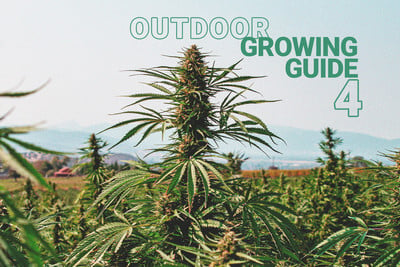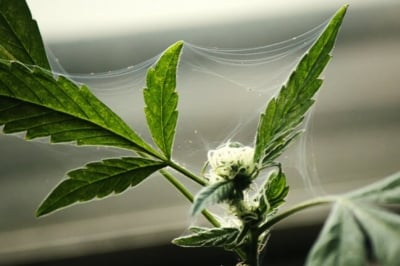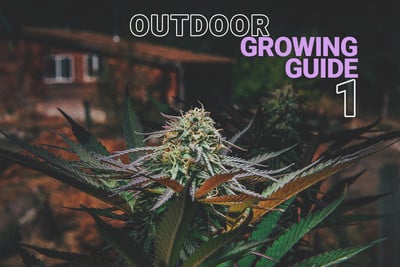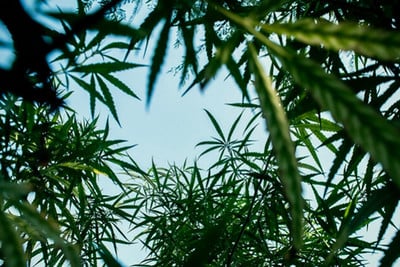.

The Basics of Cannabis Outdoor Growing (Part 2)
We’ve already chosen a strain that matches our preferences and conditions, and found a good spot. Now it’s time to think about indoor pre-vegetation, organic soils & fertilizers, and watering.
The first steps towards our common goal of large outdoor harvests for the upcoming season were already made. We’ve spent time to choose strains that match our personal preferences, and also the climatic conditions at our grow location. Now it’s time to think about a way to give our seedlings a good start in life, and how to match their needs with organic soils and fertilizers. At the end of this blog, we’re going to briefly talk about watering cannabis plants in general, and also about methods to overcome the watering issue of guerilla grows. If you’ve missed out on Part 1 covering the topics “choose the right strain” and “find a promising spot”, you can go back by clicking here.
3. Indoor Pre-Vegetation
Even though we plan on growing our cannabis plants outdoors, there are some good reasons for us to start our seedlings indoors, and then moving them outdoors later on. If you’re clueless on how to grow cannabis from seed to seedling in the first place, feel free to read this blog to get a rough idea: Rookie Guide: 3 Steps to Master the Seedling Stage
Reasons for starting plants indoors
- Temperature drops at night, frost, and storms can harm seedlings in spring (April & May)
- One can start a few extra seeds, and select only the strongest ones to move outdoors
- Full control of the environment, seedlings will get a head start
Problems associated with this method
- Moving cannabis plants from an 18/6 light cycle indoors, to 13 hours of natural daylight for instance, can shock the plant, resulting in slow growth
- The light intensity of the sun is way higher to any grow light
- A sudden change from low light intensity to direct sunlight will harm our plants (UV rays)
Solution: You’ll simply expose your seedlings to the same amount of light hours they would normally receive outside, so closer to 14 than 18 hours. Each and every day, you can add a few minutes of light, imitating the actual sunrise and sunset you check online. When you have the chance, expose your seedlings to direct sunlight, and gradually increase the amount of sunlight per day.


4. Organic Soils And Fertilizers
Cannabis is a natural plant, and enough agricultural enterprises damage soils, groundwater, and biodiversity by producing crops with mineral based fertilizers, pesticides, and all kinds of chemicals we don’t necessarily want to smoke. Organically produced buds will taste better, and future generations of growers also have the chance to practice this hobby – a classic win-win situation.
Buy high quality organic soils from the shop (easy)
- Basic rule when buying soils: Don’t be cheap!
- You can choose between different levels of pre-added nutrition
- Buy soil with “light” or low nutrition, especially for seedlings
- Try not to buy all the fertilizers and additives that exist
Re-create and enrich commercially available soil (intermediate)
- Important for guerilla growers!
- Add slowly releasing organic “fertilizers” to your soil
- Key ingredient: Home-made compost
- Dolomite lime balances the pH value
- Eggshells for calcium, epsom salts for magnesium
- Bone meal, worm castings, guano, a fish (there are many different ways)
Create your own soil mix completely from scratch (advanced)
You’re tired of paying a company to mix up your soil, and also not completely satisfied with the quality? Then learn how to mix your own soil by reading this blog: Create your own Soil Mix for Cannabis


5. Watering
Giving your plants the right amount of water is the best way to promote healthy growth. Many novice growers, and even the more experienced, tend to do overwater their plants. Guerilla growers, especially in warmer climates, often have a different problem – getting enough water to their plants.
Watering cannabis plants in general
- Get a feeling for the pot weight (completely dry, and after watering)
- One overly precise method would be to weigh your pots (dry and wet)
- Water small amounts, frequently, but also make sure some water drains through the whole pot from time to time, just a little bit though


The watering issue of guerilla grows
- Plant in walking distance (<30min) to a small river, lake or pond
- Add water-absorbing crystals or clay to your soil
- Buy “bottle adapters” for recycled plastic bottles (cheap automatic watering)














































